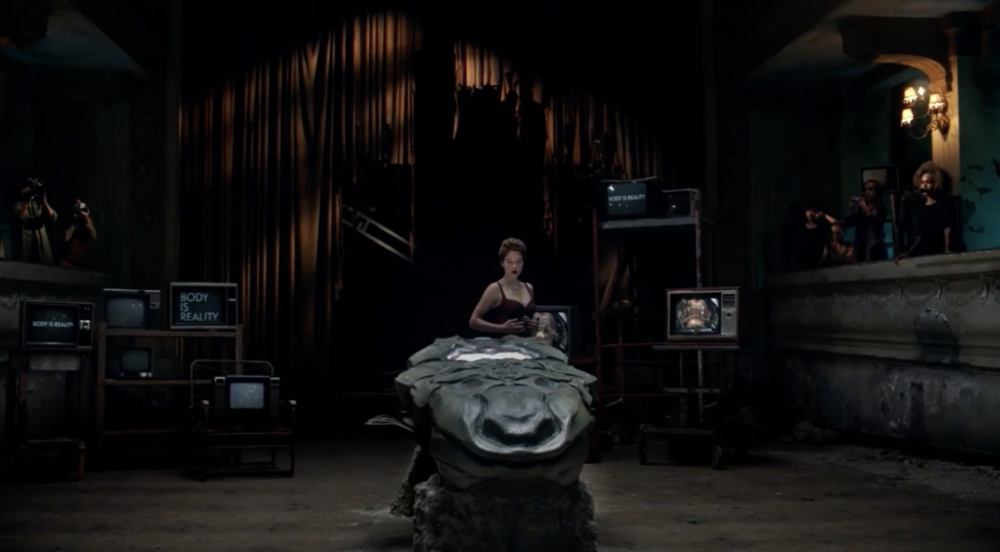Released in cinemas in September, David Cronenberg’s festival darling Crimes of the Future is a response to the history of performance art and the forms it might take in a new, speculative future.
by Sam Moore
Crimes of the Future (David Cronenberg, 2022)
In Rosa von Parunheim’s film Silence = Death (1989), there’s a famous image of the writer David Wojnarowicz with his mouth sewn shut. The title of this film, Silence = Death, was and is a rallying cry around which AIDS activism has historically formed: that for those in power to say nothing is to condemn suffering people to death. Wojnarowicz’s mouth, forced violently shut, became a visual representation of that silence, and the impact it had on people’s lives.
In David Cronenberg’s film Crimes of the Future (2022), Klinek - a performance artist played by Tassos Karahalios - is having his eyes and mouth sewn shut, as his voice repeats over a sound system in a warehouse that “it is time to listen.” While the message is an inversion of the one put forward by Wojnarowicz - that we need to listen, rather than speak - the sequence itself, and the relationship it has with the politics of the body, is ripped straight from an art history book. Full of thematic density and ambiguity, Cronenberg’s film feels like a response to the history of performance art, and the forms that it might take in a new, speculative future, where the body - so often a canvas in itself - is constantly changing. Because Klinek, mouth and eyes sewn shut, has ears all over his body: on his forehead, his chest, his arms. His body has evolved in a strange, accelerated way, and he’s made art out of that. Or tried to, anyway - reception to it in the audience is divided.
At the narrative and thematic heart of Crimes of the Future is the performance artist couple, Saul Tenser and Caprice (Viggo Mortensen and Léa Seydoux). With his cropped white hair, he’s coded like the transmasc writers you might follow on Instagram. In their joint performances, Caprice wears formal, flowing dresses, with an elaborate piece of machinery along her ribs: it lets her control the myriad surgical instruments that she uses to cut Saul open to extract the strange new organs that he’s developing as part of his own accelerated evolution. While it might be tempting to look at the two of them as a kind of mashup of couple/collaborators throughout art history, the one that feels most accurate is to think of the two of them as being a sci-fi equivalent to Bob Flanagan and Sheree Rose. It is the case in terms of the dynamic that exists between their love for each other and work together - one always informs the other, but their most intimate moments are held and cherished beyond the lights of performance - but also the purpose of their work: its philosophy and ethics.
Crimes of the Future (David Cronenberg, 2022)
As Caprice and Saul are drawn into performing an art-world-autopsy on the corpse of a young boy, she insists to the boy’s father that “performance art is all consensual,” a simple line that captures so much of what makes Crimes of the Future so fascinating: the deliberate, explicit way in which it enters a dialogue with the ethics and aesthetics of performance art. At Caprice and Saul’s performances, as her machines rapidly enter him, his body sits in an elaborate surgical chair, surrounded by monitors that proclaim, in the vein of Barbara Krueger: THE BODY IS REALITY. This is a statement that rings true in the film, but only for a moment at a time, since these bodies, and what they can become, keeps on changing. Caprice insists that the art that she and Saul are creating is a way of making order out of chaos; as if removing his new, mutant organs is able to freeze them in time. Each organ extracted from Saul is sketched out, a kind of crude documentation.
But it’s these moments - of knowing winks to art history, of the deliberate way in which Caprice defines her and Saul’s shared practice - that make it clear that Crimes of the Future is, in a way, a film about the past. Taking these ideas and institutions and assumptions - around the body; around performance art - and challenging them, forcing them to evolve. What’s interesting about Saul and Caprice is that they’re like rock stars, famous in a way that’s rarefied for real-life performance artists; given a platform that lets them show both the potential impact that their work can have, but also the hollowness it can echo within the context of the world that these collaborators inhabit.
Just as Klinek’s performance carries with it the ghost of David Wojnarowicz, the climax of Crimes of the Future also lifts from a striking moment in the history of performance art. For Saul, while he’s able to make his physical body into a body of work, this clearly comes at a price. It is another echo of the legacies of performance artists like Bob Flanagan; challenging the idea of what a body can look like, or what it can represent. And as the film itself fades to black, Saul is caught in another moment in which his body rebels. A moment that Caprice - consensually - captures on camera. It’s a moment that recalls the closing moments of Sick - Kirby Dick’s 1997 documentary about Bob and Sheree - asking the question: if the body is reality, what happens when the world ends?
Sam is a writer and editor who has contributed to Frieze, The Gutter Review, Little White Lies, and elsewhere. They are the author of All my teachers died of AIDS (Pilot Press, 2020), and Long live the new flesh (Polari Press, 2022). You can buy their books and keep tabs on new work via a sporadically updated Linktree.
Crimes of the Future was released in UK cinemas by Vertigo Releasing.


